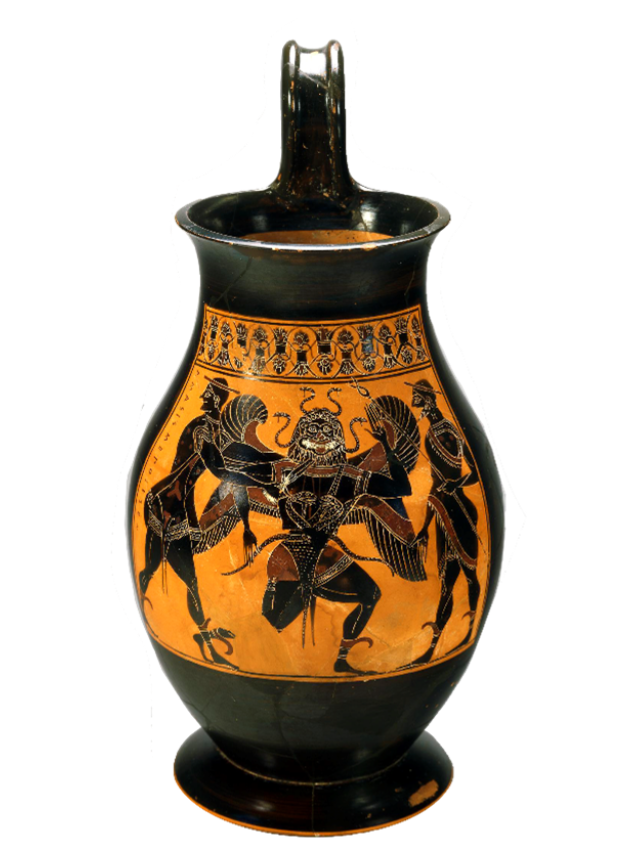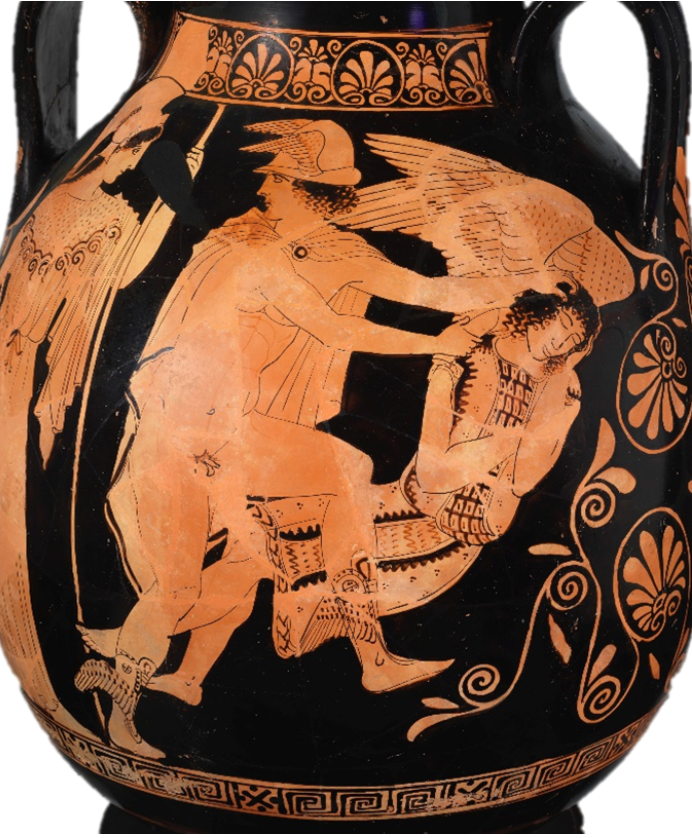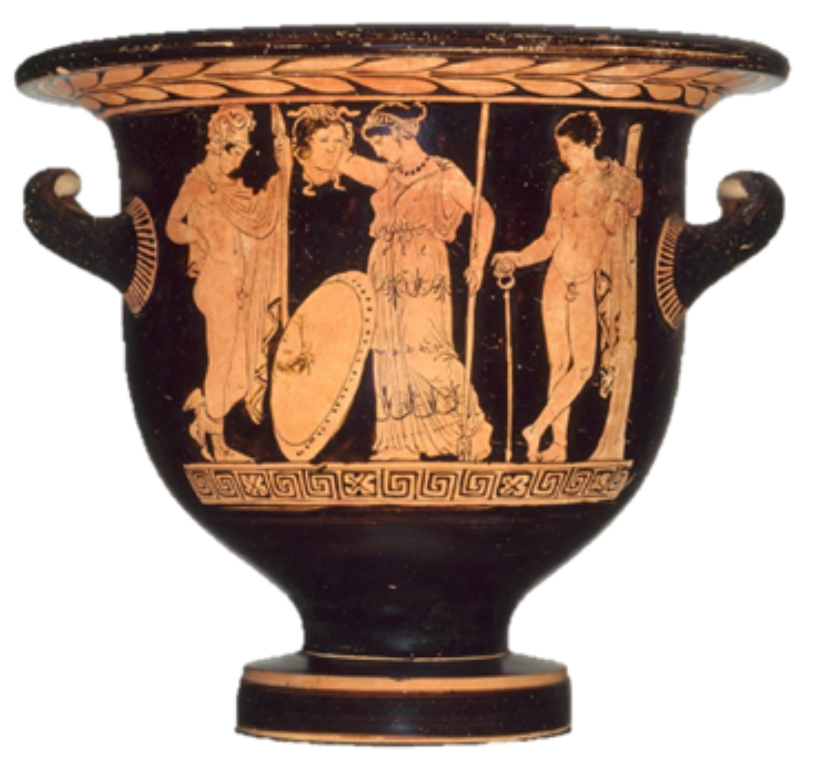The Yassification of Medusa
The myth of the beautiful, despairing maiden who transformed into a hideous snake-hybrid monster is a tale that everyone, to a lesser or bigger extent, is familiar with. We have seen the mighty hero dodge her dangerous gaze in all sorts of ways. Her ultimate fate is well-acquainted, her head being taken both as a weapon and a trophy countless times. She is, presumably, one of the most famous mythological individuals in pop culture, one of the few that nearly everyone could name without even thinking.
But who is she, Medusa, before Perseus? Before the tragic backstory? Even before her name appeared on the picture? Who, or perhaps more correctly, what is a Gorgon?
Black-figured stand depicting a Gorgoneion. Archaic Period (ca. 570 BCE) Now displayed at The Metropolitan Museum of Art, New York.
The Gorgon has had many facets attributed to its character, both literally and figuratively, since she embodies a wide range of significances with rich nuances while being portrayed in very contrasting ways.
Before jumping into Perseus myth, it is necessary to acknowledge that the so-called Gorgoneion, the iconographical depiction of the Medusa’s face, appeared before the myth and even the character of Medusa herself even existed.
Regarding the written texts, the earliest Greek sources mentioning the Gorgon, the Homeric Poems, date to the eighth century BCE. In the Illiad, the Gorgon is presented as a frightening, bodyless creature living in the Underworld, but references to snakes are nowhere to be found. The Odyssey states the same facts about the figure. There isn’t any background given in these stories about the dreadful, lonely head existing by itself in Hades, strongly suggesting that the character was well known enough to the story’s contemporary Greeks, therefore not needing any introduction.
However, Perseus is not linked with her in any way in either of the stories, even though he is mentioned several times. It is likely that the myth of Medusa’s decapitation by Perseus wasn’t fully developed yet.
The earliest portrayals of Medusa, as mentioned, generally consist of her full face alone with very distinctive features that leave no doubt of its identity, this similarity among the many different characterizations of her figure in iconography suggests some sort of standardization of her aspect in antiquity. The so-called Gorgoneia is often depicted with a very recognizable extreme expression: Medusa is displayed completely frontal and glaring instead of in profile, there is a special emphasis on her look, with her gaze stealing the picture altogether. She is consistently depicted with fierce wide-open eyes that stare out of the vase, directly at the viewer. Her eyeballs are drawn larger relative to the other facial features, the gaze possessing a haunting straight-forwardness that evokes power and haunts the viewer with its eeriness.
Black-figured olpe depicting the slaughter of Medusa by Perseus. Archaic Period (ca. 550 BCE) Now displayed at The British Museum, at London.
It didn’t take too much time until the myth scenery involving proper slaughter of Medusa, which may or may not involve other characters like Athena and Hermes as well. In this particular vase, Perseus is set spiking Medusa’s neck with his sword while Hermes watches upon them. The hero is looking away from the monster, avoiding her powerful gaze, which, once again, strikes out of the vase as she focuses on the viewer, on us. She is depicted with the same expression that we see on earlier pieces, when she was only depicted as a head, but now she is depicted with a body and often winged as well.
Countless vases began depicting scenes of Perseus' myth, which was one of the most popular heroes in Attic tradition. It is common to find some incongruences in the narrative scenes, since the myth was probably still in the making (like this funny vase of Perseus beheading a centaur Medusa), however, by the end of the Archaic Period, a canonical version of the myth of Perseus seems to be fully established.
Pithoi depicting the slaughter of Medusa by Perseus.
However, Medusa gradually acquired the looks of a young woman as the ideal of beauty in Classical Greek art gained strength. She started to become a tragic, feminine figure of a beautiful maiden killed in her sleep. She was both an aggressor and a victim, as displayed in Attic representations of her death.
It emerged slowly in the fifth century BCE, and became popular after the fourth century BCE. The character was treated in iconography pretty much like every other traditional figure, she started appearing in profile and three-quarter view, and more often than not, she was portrayed with her eyes closed, sleeping. Furthermore, she lost her exceptional features, especially her frontal orientation, but also all the attributes that made her look masculine or even beastly.
Her expression softened and where once a monster was depicted, now only a young woman remained.
Red-figured pelike depicting Perseus beheading Medusa. Classical Period (ca. 450 BCE) Now displayed at The Metropolitan Museum of Art in New York.
Since the earlier period, the face of the gorgon was always used as some sort of amulet to push away evil. Although we don’t know where the figure came from, it has been theorized that she might have Neolithic roots and might even be related to some Aegean and Near East goddesses of life and death. However, it seems that the Greeks took a common figure, ancient even for them, and gave her a backstory, but they slowly took away everything that made her powerful, especially her haunting eyes, that inverted the subject of observation, for vases are supposed to be looked at by us, not the other way around.
It becomes clear that in the early times she was a powerful mythical creature that didn’t need any introductions for people to understand who she was, and definitely didn’t need any association with heroes. And so, they turned a monster into a beautiful, despairing maiden. They reduced an ancient, powerful figure to a secondary character that had to be killed by the mighty hero to have his glorious moment.
She became beautiful, yes, but at what price?
Red-figured krater. Athena holds up Medusa’s head. Her eyes are closed, her sad expression is that of a young woman. Classical period (ca. 385 BCE) Now displaying at The Metropolitan Museum of Art at New York
Last-Minute Exile: Anna Fernández Iglesias
Hometown: Barcelona, Spain High School: Adela de Trenquelleón Like Seneca, like Aristotle, and like countless others from Classical history, you find yourself subject to an exile order, and must vacate the country tout-suite before some sort of sword-based injury befalls your neck!
You grab three records…
1. Red (Taylor's Version) - Taylor Swift
2. Piano Man - Billy Joel
3. Wish You Were Here - Pink Floyd
…two books…
1. The Name of the Wind (Patrick Rothfuss)
2. Interview with the Vampire (Anne Rice)
…a Tupperware of your favourite food…
Cannelloni
…and something else at random.
Black eyeliner
Exile is going to suck, but at least you won’t have to put up with…
Getting up early to go to work!






